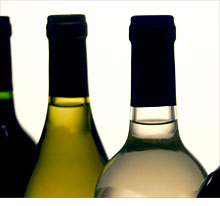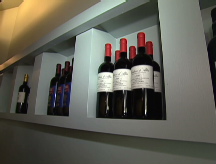Wine marketing goes high-tech
Savvy wine entrepreneurs are using video, blogs, information kiosks and other new digital tricks to erase wine's old elitist mystique.

(Fortune Small Business) -- There is perhaps no better example of the democratization of wine marketing than Gary Vaynerchuk. His almost-daily, 25-minute video rants about the subject, Wine Library TV, boast 60,000 viewers, who post an astonishing 300 to 500 comments per episode.
From the New York Jets bucket he uses to pour off extra wine during on-camera tastings to his use of adjectives like "popcorn" instead of "oak" to describe vintage flavors, Vaynerchuk seems way more accessible than your typical sommelier. He claims viewers from ages eight to 70 years old, and his blog has inspired a recent book: 101 Wines Guaranteed to Inspire, Delight, and Bring Thunder to Your World.
"I became part of the conversation instead of dictating the conversation," says Vaynerchuk, who (by day) is director of operations at Wine Library, a store in Springfield, N.J., started by his Russian immigrant father.
The Wine Library TV program actually has very little to do with Vaynerchuk's 40,000-square-foot retail store and e-commerce site, which he says reported revenue of $50 million back in 2005. That is by design - Vaynerchuk says he doesn't want to feel beholden to his suppliers when he's reviewing a particular vintage.
The program has been tough on store operations, both because of the hours Vaynerchk puts in and because he says what he thinks on his broadcasts, regardless of whether or not Wine Library is carrying the label. Vaynerchuk won't discuss his current revenue, but says he's making up for any lost sales with blogosphere notoriety that he hopes to turn into Internet marketing revenue. Last week, Wine Library TV began streaming on Internet television site Revision3, the first time the show has included advertising.
Vaynerchuk's philosophy is diametrically opposed to the approach being taken by Just Grapes, a wine shop in Chicago that specializes in corporate tastings and wine education. The store's new blog, called GrapeTube, was started specifically to help the retailer become better known with the local wine-drinking community, says Don Sritong, corporate sommelier for the $1 million operation.
GrapeTube carries video programming and blog entries that address basic wine-related questions, such as the characteristics of different grape varietals. It also offers a place where the store's wine-club members can share feedback and converse with the store's employees.
"The store gets e-mails all the time with wine questions. I figured these weren't the only people who had these questions," Sritong says. "Plus, I wanted to create a place where I could put our seminars. The blog gives us the opportunity to do all this."
It's a good time for wine merchants to reach out to new consumers: Approximately 57% of U.S. adults now admit to drinking wine, compared with 43% just eight years ago, according to the Wine Market Council, an industry association that hails from California's Napa Valley. While per-capita consumption still pales compared with European countries, it reached a record 3.02 gallons per adult in 2007. One big factor is the market influx of younger adults interested in experimenting with wine, the council reports.
The merchants are also experimenting - and new technology comes with glitches. After an initial test run, Just Grapes is completely overhauling its site navigation on GrapeTube. It's also increasing its posting frequency, adding new videos at least once a week . That change immediately paid off: Since the company started updating its video segments more frequently, traffic increased 113% in the first two weeks of June, compared with the first two weeks of May.
Fleming's Prime Steakhouse & Wine Bar in Newport Beach, Calif., is also using Internet video to demystify the wine selection process. Its site VineVoyage.com, launched in August , features some of the winemakers behind the restaurant's 100-wines-by-the-glass tasting list. The site and the video production were funded out of Fleming's marketing budget for the year, although the company declined to reveal the exact amount.
"The investment was not insignificant, but also allowed for other brand benefits including fantastic PR ... and staying a step ahead of our competition in regard to innovation," says a spokeswoman for Fleming's.
She said there have been 35,000 visitors to the site so far, each spending more than five minutes on average with the programming - a response that has exceeded expectations. The restaurant hired a New York City digital marketing company, Night Agency, to handle the site creation and updates as necessary. Because the content is focused around Fleming's 100-wines list, which is released once each year, it isn't updated with any specific frequency.
Bryan St. Amant, founder of VinterActive, a wine-marketing advisory firm in Windsor, Calif., says wine-dependent businesses do well to experiment with creating unique marketing conversations with their customers - because otherwise, customers may skip the middleman and go straight to the source. Based on its latest annual VinQuest survey of more than 3,500 wineries, VinterActive estimates that total direct sales by U.S. wineries reached a record $2.8 billion in 2007, with tasting room sales up 29%. Online wine sales grew 3% last year, while phone orders increased 33%.
Wine buyers are responding to messages that are more closely attuned to their individual preferences - so it pays for merchants to help shape those preferences, St. Amant says.
That's one reason Scott Reiner, co-founder and co-owner of Discovery Wines, a wine retailer in New York City, has invested in 11 informational kiosks spread throughout his 3,400-square-foot retail store to help customers navigate its 600 artisanal wines. The store bought the kiosks to help customers research which wines might pair well with certain foods.
"There are many people who go into a wine store and want to ask a lot of questions," Reiner says. "Others don't want to look foolish."
The kiosks, which cost Discovery Wines roughly the as much as a desktop computer - plus the up-front development fees for its custom software - have unexpectedly inspired more follow-on dialogue with store employees than originally anticipated. Rather than replacing human interactions, the kiosks are helping his staff create closer customer relationships, Reiner says.
Some wine merchants are moving even beyond the kiosk, experimenting with mobile technology that can help wine buyers retrieve pricing or review information right at the point of purchase. One example is WineZap, backed by WineCommune of Berkeley, Calif. The service covers approximately 800 retailers and allows wine buyers to price-shop inventory at those stores through searches both on the Web and on their mobile phones. Merchants pay a fee when a bottle in their store or online inventory comes up in a search result.
Likewise, Wine Library is working on an application that will let shoppers enter a wine label's UPC code on a mobile phone and download his video review of that particular bottle, if he's done one.
It's all part of Vaynerchuk's plot to transfer control of the wine conversation out of the hands of trained professionals and to those who might once have been afraid to buy off a restaurant wine list.
"Wine is the epiphany of snobbery," he declares. And, yes, the malaprop is intentional. ![]()
Weedy wine: Biodynamics, an ultra-green growing style, is taking root in U.S. vineyards.
Winning in the wine world: An aspiring winemaker checks with Ask FSB about the success rate for small-town wineries.
U.S. wine-makers flock to Argentina: The South American country's currency crisis opened the door for overseas entrepreneurs to buy its vineyards at low prices.
-
The Cheesecake Factory created smaller portions to survive the downturn. Play
-
A breeder of award-winning marijuana seeds is following the money and heading to the U.S. More
-
Most small businesses die within five years, but Amish businesses have a survival rate north of 90%. More
-
The 10 most popular franchise brands over the past decade -- and their failure rates. More
-
These firms are the last left in America making iconic products now in their twilight. More










